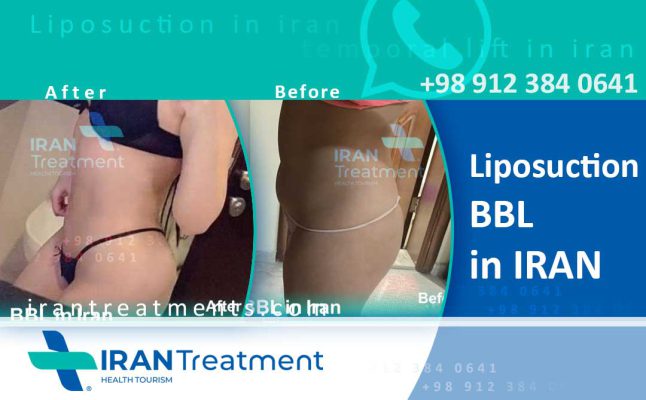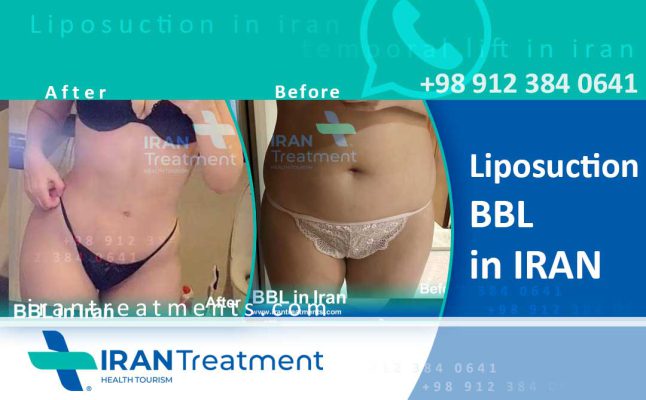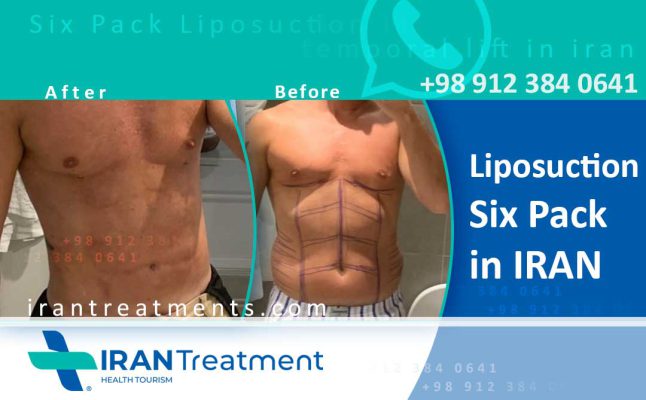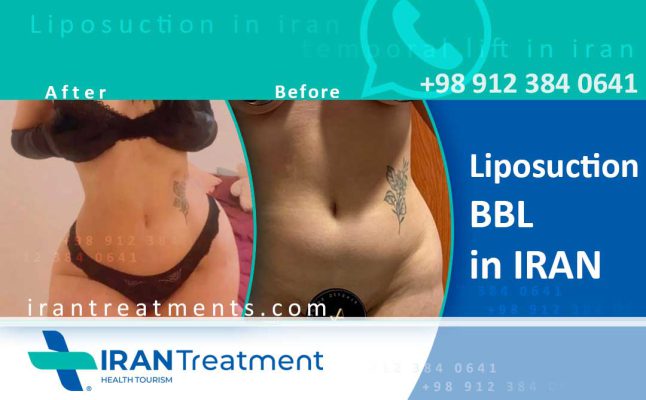Liposuction in Iran – body contours
Liposuction in Iran is a cosmetic surgical procedure that removes excess fat from specific areas of the body to improve body contours and proportions. It can be performed on various parts of the body, such as the abdomen, hips, thighs, buttocks, arms, or neck. Although liposuction can provide significant improvements, it is not a weight-loss method or a substitute for a healthy lifestyle.
The cost of liposuction in Iran
| The cost of one area Liposuction in Iran includes the following | |
| Surgeon’s salary | Between 800 and 1,200 dollars |
| Hospital and operating room fees | |
| The cost of pre-surgery tests | About 50 dollars |
| Drug cost | |
| The cost of a 7-day stay in Iran | 250 dollars on average |
| Transportation costs | Optional |
| The cost of care after surgery | Optional |
| The cost of a special garment after surgery | Between 50 and 70 dollars |
| Liposuction surgery package cost in Iran (without flight cost) | Between 1,150 and 1,550 dollars |
360 Liposuction and BBL cost in Iran: Between 2,000 and 2,800 dollars
What does 360 Liposuction in Iran include?
Lipo 360 is a liposuction procedure that encompasses all areas of the midsection, covering 360 degrees around. The corresponding areas that are able to undergo treatment include the abdominals, both upper and lower, the obliques, and the mid- to lower back.
If you are considering Liposuction in Iran or have recently undergone the procedure, here are some general tips for recovery and care. Always follow your surgeon’s specific instructions for the best results.
1. Post-operative instructions: Follow your surgeon’s guidelines for post-operative care, including medications, compression garments, activity restrictions, and wound care.
2. Wear compression garments: Your surgeon may recommend wearing a compression garment to help reduce swelling, support the treated area, and improve skin retraction. Wear the garment as instructed.
3. Manage pain and swelling: Your surgeon may prescribe pain medication or recommend over-the-counter pain relievers to manage discomfort. Swelling is normal and can be minimized by elevating the affected area and applying ice packs wrapped in a cloth, following your surgeon’s guidance.
4. Rest: Get plenty of rest during the initial recovery period. Avoid strenuous activities and heavy lifting for the timeframe recommended by your surgeon.
5. Stay hydrated and eat a balanced diet: Drink plenty of water and maintain a healthy diet to promote healing and maintain your results. Avoid excessive salt intake, as it can contribute to swelling.
6. Avoid smoking and alcohol: Smoking and excessive alcohol consumption can slow the healing process and increase the risk of complications. Follow your surgeon’s recommendations regarding smoking and alcohol consumption.
7. Gradually return to activities: Light walking can help promote circulation and prevent blood clots. Gradually increase your activity level as directed by your surgeon, but avoid high-impact exercises and heavy lifting until fully healed.
8. Attend follow-up appointments: Keep all scheduled follow-up appointments with your surgeon to monitor your progress and address any concerns.
9. Be patient with results: It may take several weeks or months for swelling to subside and the full results of your liposuction to become apparent. Maintain a healthy lifestyle to preserve your results.
It’s important to consult with your healthcare provider for personalized care instructions and to address any concerns or questions you may have regarding your recovery.
Before and after example of body contouring with liposuction in Iran
Liposuction treatment areas
The most common areas for liposuction treatment are:
• Abdomen – Liposuction of the abdomen is commonly known as ‘tummy tuck’. It removes excess fat deposits from the abdomen and helps achieve a flat tummy.
• Hips – Liposuction of hips removes excess fat from hip and buttock areas. It helps to sculpt the body and achieve an hourglass figure.
• Thighs – Liposuction of thighs removes excess fat from inner and outer thighs. It helps reduce thigh circumference and achieve slim and toned thighs.
• Buttocks – Liposuction of buttocks removes excess fat from the buttocks, especially saddlebags. It helps lift and tighten the buttocks for a shapely appearance.
• Arms – Liposuction of arms targets excess fat in the upper arm area, especially the triceps. It helps reduce arm circumference and achieve toned arms.
• Back – Liposuction of the back targets excess fat in the mid and lower back, as well as bra rolls. It helps achieve a smooth and contoured back appearance.
• Neck and chin – Liposuction of neck and chin targets excess fat in neck, jawline and chin areas. It helps reduce double chin and neck circumference and achieve a smooth jawline.
• Chest – Liposuction of the chest targets excess fat of chest, especially in males – a condition known as gynecomastia. It helps achieve a flatter and more sculpted chest.
• Calves – Liposuction of calves removes excess fat from calves to achieve slim and sculpted lower legs.
• Ankles – Liposuction of ankles targets excess fat around the ankles and lower legs. It helps improve ankle definition and contour.
So in summary, Liposuction in Iran can be used to target specific areas of excess fat deposits to help improve proportions and achieve an overall slim and sculpted appearance. The treatment areas can be prioritized based on a person’s specific problem areas and cosmetic goals.
What you can expect from Liposuction in Iran
Here are some things you can expect from a Liposuction in Iran procedure:
• Improved body contour and proportion. Liposuction is very effective at sculpting your body by removing fat from specific areas. You can expect visible improvements in your body shape and contour.
• Clothes will fit better. As liposuction reduces fat in target areas, your clothes will fit and drape better on your body. You may even go down a size.
• Metabolic benefits. Removing excess fat cells from certain areas of the body may provide some metabolic benefits. Your body’s fat distribution and insulin sensitivity may improve slightly.
• Cellulite reduction. Liposuction often helps improve the appearance of cellulite in the treated areas. The fat that causes dimpling is removed, leading to smoother skin.
• Only regional fat loss. Liposuction only removes fat from targeted treatment sites. It does not necessarily lead to overall weight loss. Fat loss occurs only in the specific areas treated.
• Temporary swelling and bruising. Swelling, bruising, and soreness for several weeks after the procedure are normal side effects of liposuction as your body heals. These will subside over time with proper rest and recovery.
• Numbness and tingling. You may experience temporary numbness, tingling, sensitivity, or hypersensitivity in the treated areas. This typically resolves in 6 to 12 weeks as nerve endings heal.
• Scarring. Liposuction will lead to tiny scars at the incision sites. However, they are usually small and fade significantly over several months. Proper scar management helps minimize appearance.
• Fairly permanent fat loss. Once removed, the treated fat cells are permanently gone. However, liposuction does not prevent future weight gain. A healthy diet and exercise is needed to maintain your new body shape and proportions.
• Multiple sessions possibly needed. For some people, multiple liposuction surgeries scheduled several months apart may be required to achieve maximum fat loss and best cosmetic outcome. Additional costs would apply.
During the Liposuction in Iran procedure
Here is what typically happens during a liposuction procedure:
1. Anesthesia – Liposuction is usually performed under local anesthesia with IV sedation or general anesthesia depending on the extent of treatment. An anesthesiologist will administer anesthesia to ensure you remain comfortable throughout the procedure.
2. Incisions – Small incisions are made in the treatment areas to insert the cannula. These incisions are usually 3 to 4 mm in size. For large volume liposuction, slightly longer incisions may be needed. The incisions are placed in inconspicuous areas as much as possible.
3. Infusing tumescent fluid – A sterile solution made of saline, lidocaine for local anesthesia and epinephrine is infused into the treatment areas through the incisions. This helps separate fat cells from surrounding tissues, provides anesthesia and minimizes blood loss.
4. Loosening fat deposits – The surgeon moves a cannula back and forth through the incisions to loosen excess fat deposits. Connective tissues separating fat pockets are broken up and fat cells detached from their blood supply.
5. Suctioning fat – Once fat is loosened, a suction tube is inserted to vacuum it away from the body. Multiple passes of the cannula and suction tube are often needed in each area to remove as much fat as possible.
6. Equalizing pressure – During the procedure fluid buildup can cause swelling. So puncture holes are made in the skin to drain excess tumescent fluid and blood, helping to equalize pressure. A compression garment is placed to control swelling as well.
7. Suturing incisions – The tiny incisions made for cannula insertion are sutured closed at the end of the procedure. Steri-strips, sutures and bandages are used to seal the incisions.
8. Post-procedure care – You will need to wear a compression garment for 3 to 4 weeks as swelling and bruising start to subside. Regular follow up visits monitor your recovery. Most patients can return to work within 7 to 14 days. More strenuous activities are resumed gradually over 4 to 6 weeks.
The procedure usually takes 1 to 3 hours to perform depending on the number of areas treated. Patients experience minimal discomfort due to the anesthesia. Side effects like swelling, bruising and soreness are common post-operatively but managed well with medication and compression garments.
care after Liposuction in Iran
After liposuction, it is important to follow proper care instructions to ensure a smooth and safe recovery. Here are some general guidelines for care after liposuction:
1. Wear compression garments: Your surgeon will likely recommend wearing compression garments for a certain period of time after the procedure. These garments help reduce swelling, promote healing, and improve the cosmetic outcome of the procedure.
2. Take pain medications as prescribed: Pain and discomfort are normal after liposuction, and your surgeon may prescribe pain medications to help manage these symptoms.
3. Follow a healthy diet: Eating a healthy diet can help promote healing and reduce the risk of complications. Focus on eating a nutrient-rich diet with plenty of fruits, vegetables, lean protein, and whole grains.
4. Stay hydrated: Drinking plenty of fluids can help reduce swelling and promote healing. Aim to drink at least 8 glasses of water a day.
5. Avoid strenuous activities: You should avoid strenuous activities, including exercise, for at least a few weeks after the procedure. Your surgeon will provide specific instructions based on your individual case.
6. Attend follow-up appointments: It’s important to attend all follow-up appointments with your surgeon to ensure that you are healing properly and to address any concerns or complications that may arise.
It’s important to note that the specific care instructions may vary depending on the individual case and the type of liposuction performed. Be sure to follow your surgeon’s instructions carefully to ensure the best possible outcome.
Types of liposuction devices
There are several types of liposuction devices available, each with its own advantages and disadvantages. Here are some of the most common types:
1. Traditional liposuction: This involves using a cannula (a thin, hollow tube) to manually suction fat from the body. The cannula is attached to a vacuum device, which removes the fat.
2. Power-assisted liposuction (PAL): This technique uses a special cannula that vibrates rapidly back and forth, helping to break up fat deposits and make them easier to remove.
3. Ultrasound-assisted liposuction (UAL): This technique uses ultrasound waves to liquefy fat cells, making them easier to remove with a cannula. UAL can be particularly effective for removing fat from areas with dense, fibrous tissue, such as the back or chest.
4. Laser-assisted liposuction: This technique uses a laser to liquefy fat cells before they are removed with a cannula. Laser-assisted liposuction can be particularly effective for targeting small areas of fat, and may also help stimulate collagen production for tighter, smoother skin.
5. Water-assisted liposuction (WAL): This technique uses a jet of pressurized water to break up and remove fat cells. WAL is considered less invasive than traditional liposuction, and may also result in less bruising and swelling.
6. Radiofrequency-assisted liposuction (RFAL): This technique uses radiofrequency energy to heat and liquefy fat cells, making them easier to remove with a cannula. RFAL can also help tighten skin and stimulate collagen production for a smoother, more youthful appearance.
Your surgeon will recommend the best type of liposuction device based on your individual needs and goals, as well as the location and amount of fat to be removed.
vaser Liposuction in Iran
Vaser liposuction is a type of ultrasound-assisted liposuction (UAL) that uses high-frequency sound waves to break up and liquefy fat cells, allowing them to be more easily removed from the body. The “vaser” in vaser liposuction stands for “vibration amplification of sound energy at resonance.”
During the vaser liposuction procedure, a small probe is inserted into the treatment area through a small incision. The probe emits high-frequency sound waves that break up the fat cells without damaging surrounding tissues such as blood vessels and nerves. The liquefied fat is then removed from the body using a thin cannula.
One of the benefits of vaser liposuction is that it can be used to target specific areas of the body with high precision, making it ideal for sculpting and contouring. It can be used to treat areas such as the abdomen, hips, thighs, arms, and chin. Another benefit is that vaser Liposuction in Iran can help stimulate collagen production, which can result in tighter, smoother skin.
Like all types of liposuction, vaser liposuction is a surgical procedure that carries certain risks and requires a recovery period. It is important to consult with a qualified and experienced plastic surgeon to determine if vaser Liposuction in Iran is right for you, and to discuss the potential risks and benefits of the procedure.
PAL Liposuction in Iran
Power-assisted liposuction (PAL) is a type of liposuction that uses a specialized cannula (a thin, hollow tube) that vibrates rapidly back and forth to help break up and remove fat cells from the body. The vibrations of the PAL cannula make it easier for the surgeon to remove fat cells with less force, which can result in less trauma to the tissues and a quicker recovery time for the patient.
During a PAL liposuction procedure, the surgeon makes small incisions in the treatment area and inserts the vibrating cannula through the incisions. The cannula is attached to a vacuum device, which removes the broken-up fat cells from the body. The surgeon can control the speed and intensity of the vibrations to achieve the desired results.
PAL liposuction can be used to treat many areas of the body, including the abdomen, hips, thighs, buttocks, arms, and back. It is particularly effective for treating dense, fibrous areas of fat that may be difficult to remove with other types of liposuction.
Compared to traditional liposuction, PAL liposuction may result in less bruising and swelling, and a quicker recovery time. However, like all types of liposuction, PAL liposuction is a surgical procedure that carries certain risks and requires a recovery period. It is important to consult with a qualified and experienced plastic surgeon to determine if PAL Liposuction in Iran is right for you, and to discuss the potential risks and benefits of the procedure.
The advantage of the Pal device is that most of the fat remains alive during liposuction
This makes it have better results and durability in fat injection than other liposuction devices
Possible risks and complications of Liposuction in Iran
Like any surgical procedure, liposuction carries certain risks and potential complications. Here are some of the most common risks and complications associated with liposuction:
1. Bruising and swelling: Bruising and swelling are common after liposuction, and can last for several weeks.
2. Pain and discomfort: Pain and discomfort are normal after liposuction, and can be managed with pain medications.
3. Infection: Infection is a risk with any surgical procedure. Your surgeon will take steps to minimize the risk of infection, but it can still occur.
4. Bleeding: Liposuction may cause bleeding, especially if large amounts of fat are removed.
5. Fluid accumulation: Fluid can accumulate in the treated area after liposuction, leading to swelling and discomfort. Your surgeon may insert a small drain to help remove excess fluid.
6. Numbness or tingling: Liposuction can cause temporary numbness or tingling in the treated area.
7. Irregularities or contour deformities: Liposuction can result in irregularities or contour deformities, especially if too much fat is removed or if the area is not properly contoured.
8. Skin discoloration: Some patients may experience temporary skin discoloration after liposuction.
9. Blood clots: Blood clots are a rare but serious complication of liposuction. Your surgeon will take steps to minimize the risk of blood clots, such as encouraging you to walk around as soon as possible after the procedure.
It is important to discuss the risks and potential complications of liposuction with your surgeon before undergoing the procedure. Your surgeon can help you understand the risks and benefits of the procedure, and can recommend steps to help minimize the risk of complications.






